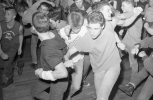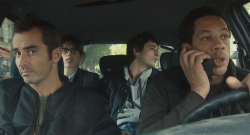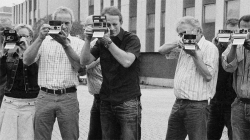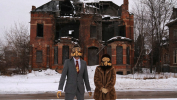Reviews
David Redmon and Ashley Sabin
USA, 2011
Credits
Review by Katherine Follett
Posted on 18 May 2012
Source Projected DVD
Categories The 2012 Independent Film Festival Boston
Americans love the dark side of modeling. Stories about enforced anorexia, sexual exploitation, and cocaine-fueled binges go viral every week. It’s a familiar story of the grime behind the glamour, the insistence that no one can look so perfect without something horrible under the surface.
The truth that comes out in Girl Model, the second documentary at the 2012 IFFB from filmmaking couple David Redmon and Ashley Sabin, is more mundane, yet in many ways more horrifying. (Their other film was Downeast, a documentary of a New England industrial revival.) Agency scout and former model Ashley Arbaugh discovers Nadya, a lovely heart-faced Siberian girl, and hires her to model in Asia. The film unfolds along two tracks; the first is the giddy promise and the heartbreaking ordeal that Nadya endures. The second is the sinister contradiction at the heart of Arbaugh’s work and possibly her soul.
The film opens at the Russian modeling audition where Nadya is discovered, picked out of a seemingly endless lineup of almost identical pale, bird-limbed preteens. Nadya gives different numbers for her age depending on what the agents want to hear. In fact, she is just 13. “They like them young,” Arbaugh notes of the Asian fashion market. “Really, really young.” Nadya comes from a grim village, and her family doesn’t have much money. Nadya’s family and entire town see her modeling opportunity as a great boon, and they honor her with ceremonies, parties, and a bittersweet send-off. But once she lands in Tokyo, the fantasy abruptly shatters. She’s dropped in the largest city in the world with no guide and no translator. She speaks neither Japanese nor English, the language most often employed by the international fashion industry. Eventually, she finds her way to the agency-rented apartment, a closet-sized hovel she shares with another teenage model. She has no contacts, no cash, and no way to communicate. Though Nadya is tall and lovely, she is clearly a child. Desperate and helpless, she even pleads with the filmmakers to help her; one of them eventually provides her with a working phone, on which she sobs to her mother and begs to come home, like a terrified child at summer camp. The conditions are so bad that her flat-mate purposely eats until she gains two centimeters around her hips, violating her contract and getting sent home early. The cold, robotic feel of digital video adds to the grimness of Nadya’s circumstances, both in Siberia and the alienating urban efficiency of Tokyo. The merciless lighting and clinical cinematography make Nadya and the other models look like waxen figurines, all blue veins and skin shining tight over skeletons.
The jobs Nadya’s agency promised are in truth only auditions, and only one of them pans out to an actual photo session. Nadya’s contract sounds like something out of the old Hollywood studio system, or a major-label record deal. The company invests an enormous amount of money up front for scouting, travel, lodging, auditions, and even the shoots themselves, which the model must pay back, plus interest, from her pittance earnings before she gets to keep a dime. Intertitles reveal that Nadya left Tokyo not with the financial blessings her family hoped for, but with thousands of dollars of debt and exactly one addition to her portfolio to show for it. At one point, the filmmakers try to corner the Japanese representative of Nadya’s agency, asking how, exactly, they can run a business that drags hundreds of Russian girls to Japan and back with almost no product to show for it. The agent gives a vague non-answer about girls willing to do anything to get photos for their “books.” Clearly, the truth is that these modeling agencies are little more than extortion machines. No body-image horror, no sexual favors, no drugs; just the simple and terribly common transfer of money from the less powerful to the more powerful.
Exposing this corruption would be fodder enough for a documentary even if the agency and the fashion industry were faceless monsters. Instead, Redmon and Sabin have Ashley Arbaugh. At the beginning of the film, Arbaugh comes across as thoughtful and conflicted. She seems to cringe at the objectification her job requires, yet also captivated by the beauty of the girls she finds. Never once does she seem completely comfortable with her task. When we get glimpses of a video diary Arbaugh kept when she herself modeled in Asia, we can see why. Exhausted, bloodless, defeated, sometimes weeping, she expresses an alienation and hopelessness that perfectly echoes Nadya’s current feelings. If anything, Arbaugh in flashback is even more sympathetic, because she was older than Nadya and better able to express herself. Why, then, does Arbaugh continue to work as a scout? Is she another victim, older and slightly more wary, but still at the mercy of the machine?
There may not be a clear answer, but there’s obviously something dark and confusing under Arbaugh’s concerned façade. The filmmakers follow her to her exquisite modernist estate in Connecticut, where she keeps an unnerving trove of photos of the girls she has scouted—haunted, semi-pornographic Polaroids of just their feet and legs. We hear her babble oddly about having a baby, even comparing a fibroid tumor she must have removed to a fetus. She puts on a face of concern and horror as she describes how some agencies sell their models’ photos to unsavory industries she refuses to define (the understanding is pornography) but then nonchalantly notes that many models find it “natural” to become prostitutes to make ends meet. And at the end, after we watch Nadya and her family stripped of thousands of dollars they don’t have, we see Arbaugh smilingly tell another round of hopeful Russian families that “all the girls make money in Tokyo. Always.” It is impossible to know whether Arbaugh is evil or simply unstable. It is clear, however, that she is fully complicit in the exploitation that ensnared Nadya and continues to trap girls just like her (the film ends with Arbaugh spotting another hopeful face in another crowd, a girl whose experienced friend coaches her to add two years to her age and call herself 15.) If anything, she is worse than the slimy Russian agency representative or the overly slick Japanese hipster; a seemingly sympathetic person who understands the victim’s predicament, but uses that empathy to make herself a better predator.
After Redmon and Sabin’s Q&A, it’s clear they could have made an even deeper, darker film detailing the layers of deception and self-deception that made Arbaugh tick. As it is, Girl Model tries to keep the two story lines in balance, giving equal time to Nadya’s exploitation and Arbaugh’s instability, which unfortunately leaves many unanswered questions about the latter. Nadya’s story is more simple, and consequently more completely told, than Arbaugh’s, and it leaves the viewer wanting a bit more.
But a film that raises more questions than it answers is not a bad thing, especially in a documentary, when access and timing may limit what a filmmaker can show. Both stories in Girl Model are harrowing and fascinating. They shed new light on an industry that we see everywhere but know little about, even when we revel in its supposed “dark side.”
More The 2012 Independent Film Festival Boston
-

Beauty is Embarrassing
2012 -

Gregory Crewdson: Brief Encounters
2012 -

Sleepwalk with Me
2012 -

Liberal Arts
2010 -

Burn
2012 -

All-Ages: The Boston Hardcore Film
2012 -

Polisse
2011 -

Sun Don’t Shine
2012 -

Headhunters
2011 -

Cerro Rico, Tierra Rica
2011 -

Time Zero: The Last Year of Polaroid Film
2011 -

Jason Becker: Not Dead Yet
2012 -

Detropia
2012 -

Girl Model
2011 -

Under African Skies
2012 -

The Central Park Effect
2012 -

Paul Williams: Still Alive
2011 -

Trishna
2012 -

The Queen of Versailles
2012
We don’t do comments anymore, but you may contact us here or find us on Twitter or Facebook.



